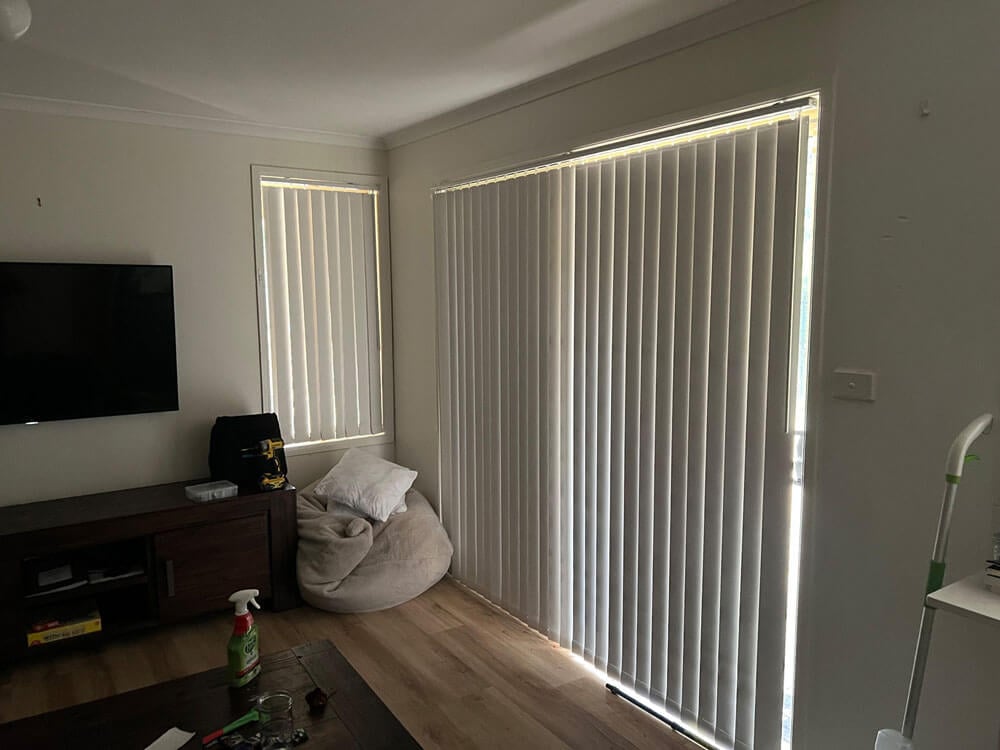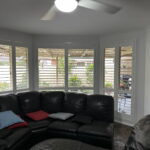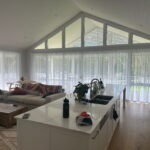Are Vertical Blinds Energy Efficient
Are Vertical Blinds energy efficient is one of the biggest considerations for Australian homeowners when choosing new window furnishings. With energy prices on the rise and summers becoming increasingly hot, more people are looking for smart ways to reduce their heating and cooling costs without sacrificing comfort or style. So, are vertical blinds energy efficient? The answer is yes — when chosen and installed correctly, vertical blinds can significantly improve your home’s energy performance by helping regulate temperature, light, and airflow.
Check out our Blinds by Room guide and Blinds by Window guide for expert advice on choosing the perfect window coverings for every space and window style in your home.

How vertical blinds help with energy efficiency
Vertical blinds are designed with practicality in mind. Their ability to tilt, rotate, and fully retract makes them one of the most adaptable window furnishings available. This flexibility plays a major role in how energy efficient they can be.
1. Summer heat reduction
During Australia’s warmer months, windows are one of the main sources of heat gain inside the home. Vertical blinds help prevent this by blocking sunlight before it can raise indoor temperatures. Blinds with reflective backing are especially effective, as they bounce sunlight and heat away from your living areas. By keeping your rooms cooler, you’ll naturally rely less on air conditioning, reducing energy consumption and lowering your electricity bill.
2. Winter insulation
When the weather cools down, vertical blinds continue to work in your favour. The vertical slats act as a thermal barrier, trapping a layer of still air between the blind and the glass. This buffer helps reduce heat loss and keeps warm air inside your home for longer. By minimising drafts and cold air from entering through the windows, vertical blinds make your heating system work more efficiently. This insulation effect is subtle but adds up to measurable savings over time.
3. Light and glare control
Another reason vertical blinds are energy efficient is their precise control over light. By adjusting the angle of the slats, you can let in just the right amount of natural light without overheating the room. This means you can brighten your space during the day without switching on artificial lights, which reduces overall electricity use.
Proper light control also prevents glare on screens, making vertical blinds perfect for living rooms, home offices, and entertainment areas. You get both comfort and efficiency from one simple adjustment.
4. Draft reduction
Even well-insulated homes can experience small drafts around windows, particularly in older properties. Vertical blinds help reduce these cold air leaks by acting as an additional barrier. While they don’t replace double glazing or full window sealing, they do provide an extra layer of comfort and efficiency, especially when combined with well-fitted tracks.
Why vertical blinds are energy efficient in Australian homes
In Australia’s mixed climate — from humid summers on the Central Coast to cooler inland winters — temperature management is key to year-round comfort. Vertical blinds are energy efficient because they adapt easily to both extremes. Their adjustable slats make it possible to block intense afternoon sun, diffuse soft daylight, or completely open up windows when you want airflow.
This dynamic design gives homeowners more control over indoor conditions without constantly adjusting the thermostat. The less your air conditioning or heater runs, the lower your overall energy usage and environmental footprint.
Furthermore, because vertical blinds can cover large expanses of glass — such as sliding doors and wide windows — they provide an energy-efficient solution for spaces where other window coverings would be impractical or too costly.
Tips for maximising the energy efficiency of vertical blinds
While vertical blinds are energy efficient by nature, there are a few key ways to make them perform even better.
1. Choose the right material
The material of your blinds directly affects their insulation performance. Fabric blinds with thermal lining or reflective coatings are ideal for managing heat. PVC and vinyl options are also effective because they resist heat transfer and block UV rays.
If you live in an area with strong sunlight, look for fabrics that have been specially treated to reflect solar energy. These materials can dramatically reduce indoor heat gain while protecting your furniture and flooring from fading.
2. Consider colour and finish
Colour makes a noticeable difference in how energy efficient your vertical blinds are. Lighter-coloured blinds reflect sunlight and heat, making them ideal for sunny, north-facing windows. Darker tones, on the other hand, are better suited for cooler rooms or where you want to absorb warmth.
If your home gets both hot summers and cold winters, a neutral mid-tone fabric can strike a good balance between reflection and insulation.
3. Ensure correct installation
Even the best blinds won’t be energy efficient if they’re poorly fitted. To get the full benefit, ensure your vertical blinds cover the entire window area, with minimal gaps at the sides. A close fit helps block drafts and reduce unwanted airflow.
Professional installation ensures the blinds hang straight, glide smoothly, and sit snugly within their tracks. This precision not only looks better but also maximises thermal efficiency year-round.
4. Use them strategically
Vertical blinds are energy efficient because they’re adaptable — but they work best when used with awareness. During summer days, close them on the sunniest sides of your home to prevent heat buildup. In winter, open them during daylight hours to let in warmth, then close them at night to trap the heat. This simple daily routine can significantly cut your heating and cooling costs.
The environmental benefit of vertical blinds
Beyond saving money, vertical blinds contribute to a more sustainable household. By improving temperature control and reducing energy demand, they help lower your carbon footprint. Less reliance on artificial heating and cooling means fewer greenhouse gas emissions — a small but meaningful step toward eco-friendly living.
Additionally, many modern vertical blinds are made with recyclable materials and low-impact manufacturing processes. Choosing high-quality, locally made blinds supports both environmental sustainability and Australian industry.
Why more homeowners are making the switch
With all these advantages, it’s no surprise that vertical blinds remain one of the most energy efficient and versatile window coverings available. Their sleek, contemporary design complements a wide range of interiors, from family homes and apartments to offices and retail spaces.
They’re also practical — easy to clean, resistant to moisture, and suitable for high-traffic areas. Whether you’re renovating, building, or just updating a room, vertical blinds offer lasting performance and everyday comfort that extends far beyond aesthetics.
Where to get energy-efficient vertical blinds
If you’re ready to make your home more comfortable and energy efficient, The Blind Crew can help. We supply and install high-quality Australian-made vertical blinds that balance style, durability, and insulation. Each blind is custom-measured for a perfect fit and professionally installed to maximise efficiency and visual appeal.
With a wide selection of fabrics, colours, and materials available, The Blind Crew makes it easy to achieve the perfect balance of light control and energy savings — without the wait.
Looking for blinds in your local area? Find your suburb here to see if The Blind Crew services your location.
Please Note: The Blind Crew specialises exclusively in the supply and installation of custom-made blinds, shutters, and awnings.
We do not offer blind cleaning or repair services.
For trusted maintenance options, visit Jim’s Cleaning Blinds Division 131 546 or Amazing Blind Repairs 1300 138 150.
Fast Turnaround – Blinds, Shutters & Outdoor Awnings Installed Quickly
- Roller blinds: Installed within just a few days (pending fabric stock by Australian suppliers)
- Electric Motors: Installed within just a few days (pending Stock)
- Indoor blinds: (vertical, venetian, roman, panel): 7–14 days
- Plantation shutters: 3–4 weeks
- Outdoor blinds & awnings: 3–4 weeks






Explore Our Complete Product Range
- The Blind Crew offers roller blinds, verticals blinds, venetian blinds, roman blinds, panel blinds, double roller blinds, plus Plantation shutters, curtains including blackout curtains, Sheer curtains, Double curtain rods; outdoor blinds and awnings and smart home, electric blinds motorisation — all custom made for your home.

